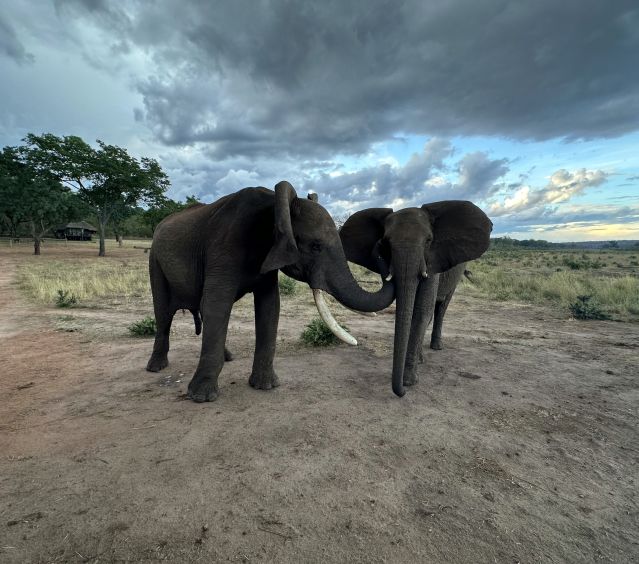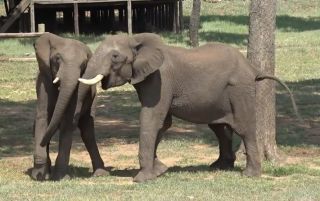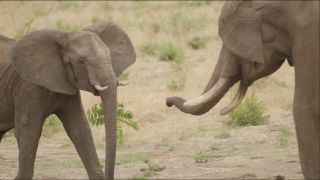Animal Behavior
How Does an Elephant Say Hello?
Analyses of elephant greeting rituals offer a window into their minds.
Posted May 9, 2024 Reviewed by Michelle Quirk
Key points
- Researchers studied the multisensory greeting displays used by African elephants during reunions.
- Greetings comprised specific combinations of vocalizations like rumbles and gestures like ear-flapping.
- Elephants changed their communication methods depending on whether the other elephant was looking at them.

Like other species that live in multi-level societies, African savannah elephants regularly separate and reunite. Vesta Eleuteri of the University of Vienna says that during reunions, elephants greet each other with a suite of different vocalizations and body movements (and sometimes defecation and urination).
“When two family groups meet, they engage in this elaborate ritual of everyone running to each other and saying hello in all their different ways,” she says.
In a new study, Eleuteri and colleagues show that elephants use specific combinations of vocalizations and gestures to greet each other and that they may deliberately change their communication methods depending on whether the other elephant is looking at them or not.
Multisensory Salutations
According to Eleuteri, most studies of elephant communication have focused on the animals’ acoustic and olfactory signals, and not on their physical actions.
“We wanted to understand if these body movements represent communicative gestures targeted at the recipient, and how gestures and vocalizations might be combined during greetings,” she says.
Eleuteri and colleagues observed a group of nine semi-captive African savannah elephants living in the Jafuta Reserve, Zimbabwe. They studied the vocalizations and physical actions the elephants used when greeting each other after a brief separation.

The researchers found that elephants used specific combinations of vocalizations and gestures during reunions. The most frequently used combination was rumbling vocalizations with ear-flapping gestures, and it was used most between females.
In addition, the elephants often urinated, defecated, or exhibited secretions from their temporal glands, suggesting that olfactory signals may contribute to their greetings.
Eleuteri says that some of the physical actions she and her colleagues observed, such as raising or waggling the tail, were not targeted visually to the elephant being greeted. “My perception was that these movements could contribute to their olfactory communication,” she says. “These are actions they use to tell the recipient, ‘Smell me’ or ‘I’m presenting you with my smell,’ which for them is very relevant.”
Elephant Minds
The researchers also found that elephants used different methods of communication depending on whether the subject of their greeting was looking at them. When they were being watched, the animals were more likely to use visual gestures, such as ear-spreading or trunk-swinging. But when the other elephant was not paying attention, they were more likely to use sound-producing gestures like ear-flapping or to touch the recipient of their greeting.
Previous research has shown that chimpanzees and other apes also combine vocalizations with gestures and change their communication methods depending on whether they are being watched. Finding these capacities in elephants suggests they evolved independently in these distantly related species. Elephants may be physically different from apes (including humans), but they share with us a long lifespan, complex social life, and sophisticated cognition—traits that may favor the evolution of complex communication.

Eleuteri recently returned from five months of fieldwork where she studied wild and semi-captive elephants to try to understand the flexibility of their use of gestures. She says that although most of the movements elephants make have been observed and catalogued, it is still unclear if they are communicative and, if so, what they communicate.
“My long-term goal is to define the gestural repertoire of elephants in the wild—all the different forms of gestures that they use and the meanings of those gestures,” she says.
“What is particularly exciting for me is that with this focus on gestures, we are stepping into a new realm of elephant communication, and a window into their minds, which has been relatively neglected.”
References
Eleuteri V, Bates L, Rendle-Worthington J, Hobaiter C, and Stoeger A. 2024. Multimodal communication and audience directedness in the greeting behaviour of semi-captive African savannah elephants. Communications Biology. Doi: 10.1038/s42003-024-06133-5.


